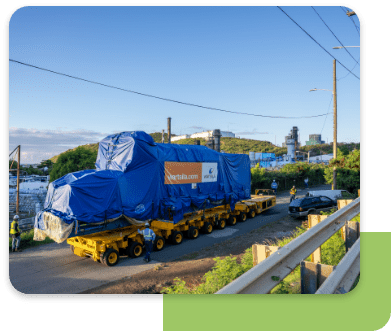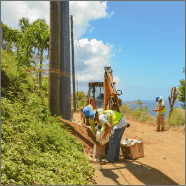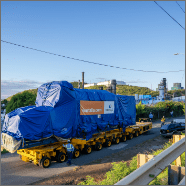Infrastructure
Click here to view.
- National Objective
- Eligible Activity
- CDBG Disaster Recovery Eligible Activities HUD Exchange Webinar Training In Newark, NJ
CDBG-DR Federal Notices and Other Federal Regulations
- Davis Bacon and Labor Standards
- Section 3
- HUD Rider
- Employee Payroll Form
Overview
The CDBG-DR Infrastructure Programs are designed to address unmet disaster recovery needs related to damage from Hurricanes Irma and Maria. Residents not only suffered from direct damage to their homes from the hurricanes but also endured the loss of critical services such as power and water due to damaged public infrastructure.
The Transportation networks were devastated throughout the islands. Flooding, stormwater overflow, soil erosion, culvert failures, mudslides, potholes, complete washouts, and other damages to road infrastructure inhibited freedom of movement throughout the Territory.
Hardening public facilities and networks, such as wastewater, potable water systems, solid waste, telecommunications, and public roads, is critical to the Territory’s ability to respond swiftly in the aftermath of an extreme weather event. If the Territory’s infrastructure is made more resilient, critical services could be stabilized and maintained for residents in the event of a future disaster, creating a safer and more secure environment.

Objectives
- Prioritize infrastructure projects that directly support low-moderate communities.
- Identify infrastructure projects that are more resilient, that provide critical services that stabilize and maintain for residents in the event of a future disaster.
- All infrastructure programs will meet a HUD national objective. The most applicable national objective for infrastructure will likely be LMI benefit.
- A subcategory of LMI benefit is the low- and moderate-income area benefit (LMA). LMA allows activities that benefit all persons in a particular service area to count towards the LMI objective when at least 51% of residents in the service area are classified as LMI.
- Determine the appropriate service area based on factors including: the nature of the activity; the location of the activity; accessibility issues; the availability of comparable activities; and boundaries for facilities and public services.
- Ensure that projects will be prioritized to provide services to LMI persons and support unmet housing needs.
- Ensure URA/104(d) compliance and required actions are followed.
- Ensure projects include comprehensive planning to identify resilience opportunities and adoption and enforcement of codes to bring critical infrastructure up to industry standards.
- Ensure holistic mitigation designs strive to meet future challenges and hazards.
- Encourage implementation of innovative technology and other best practices to create a more reliable, sustainable, and cost-effective electric grid.
- Consider the mitigation components protect against future damages.
- Proactive measures to promote risk-informed infrastructure development include diversification of power generation, micro-grid development, relocation of critical facilities, and flood-mitigated roads.
- HMGP funding for important mapping and hydrologic studies are anticipated to be obligated soon, which will provide up-to-date data and land use recommendations that are critical for roads and power-related projects.
- Leveraging other funding sources and increasing coordination among public and private utilities.
- Optimize the use of CDBG-DR funds by reducing the unmet need for infrastructure resilience programs.
- Replace or restore the function of a facility or system to industry standards without regard to the pre-disaster condition of the facility or system.
- Replace or restore components of the facility or system not damaged by the disaster where necessary to fully effectuate the replacement or restoration of disaster-damaged components to restore the function of the facility or system to industry standards.
Financials


Local Match for Federal Disaster
$233,908,543
In most cases, federal programs require local government organizations to pay a share of the cost of a project, called the “local match.” The Territory will ensure that each project which qualifies for funding under the Local Match for Federal Disaster Relief Program corresponds to a CDBG-DR eligible activity, meets a national objective, and demonstrates a direct connection to the disaster. Funds will be provided as payment to governmental agencies, eligible organizations, or other entities for eligible activities within approved PWs or relevant documentation from other agencies.
Questions? Contact Verline Constable Senior Infrastructure Manager, vconstable@usvipfa.com

Infrastructure Repair & Resilience
$70,619,443
Hardening public facilities and networks is critical to the Territory’s ability to respond swiftly in the aftermath of an extreme weather event. A high priority for the U.S. Virgin Islands will be funding activities that mitigate damage to utility, transportation, and telecommunications networks, particularly for the facilities and networks that serve the health and safety of the community. As of April 27, 2018, the Territory has identified several resilience and mitigation measures, which include hardening public facilities (e.g., water pump stations, public schools), installing on-site power generation, burying utility lines, reducing the risk of storm water runoff erosion and flood exposure, and extending utility services to isolated populations.
Questions? Contact Verline Constable, Senior Infrastructure Manager, vconstable@usvipfa.com

Electrical Power Systems Enhancement & Improvement
$89,190,097
The main objectives of the Electrical Power Systems Enhancement and Improvement Program will be to invest in optimizing the generation mix, improving asset productivity, and providing more sustainable, more reliable, and more cost-effective energy for the U.S. Virgin Islands. The program will help to reduce the Territory’s dependence on oil and propane by allowing for projects that replace existing, conventional generator units with advanced, high efficiency technologies or build new capacity with more advanced technologies. Such projects may also have health and environmental benefits to improve air quality for communities near the power generation plants and decrease the overall emissions into the atmosphere.
Questions? Contact Verline Constable, Senior Infrastructure Manager, vconstable@vihfa.gov

